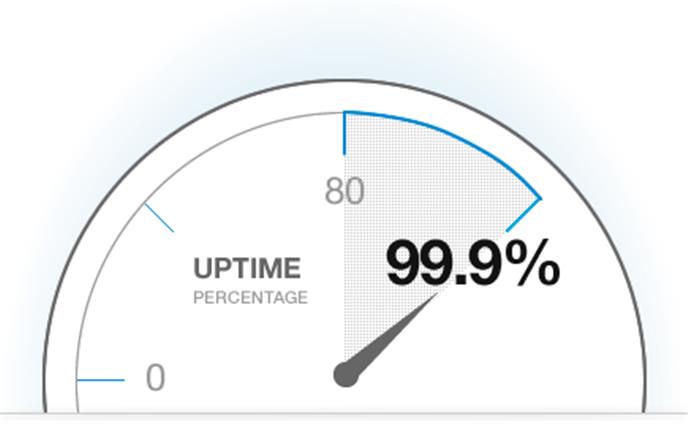Best Practices for Maximizing Your Website and M-Commerce Uptime
By Alex Carter on October 22, 2024
In today’s digital age, ensuring high uptime for your website and M-commerce platforms is critical to the success of your brand and customer satisfaction. With E-commerce and M-commerce both playing pivotal roles in business, keeping your website running smoothly, with minimal downtime, directly impacts your revenue and customer retention. Here’s a comprehensive guide that merges the best practices for increasing uptime for both traditional websites and M-commerce platforms.

Ensure Your Site is Mobile First
With mobile commerce (M-commerce) on the rise, it’s essential to prioritize mobile design. Forrester reports significant growth in mobile transactions, making it crucial to think Mobile First. Unlike the past where desktop websites were adapted for mobile devices, today’s strategy should start by coding for mobile users first, followed by enhancement for desktop and tablet users. By focusing on mobile, you ensure seamless experiences for the largest and fastest-growing audience segment.
Check Your Web Hosting
Your web hosting service is fundamental to ensuring high uptime. Unlimited bandwidth doesn’t always guarantee quality performance. Shared hosting environments can lead to bandwidth competition, negatively affecting your website’s performance. It’s vital to choose a hosting provider that offers 99.99% uptime and sufficient dedicated resources to prevent downtimes that can affect your bottom line.
Reduce Page Load Time
In both traditional websites and M-commerce, speed is everything. If a mobile site takes longer than 4 seconds to load, 1 in 4 visitors will abandon it. To avoid this, compress large files like JavaScript and images to ensure faster load times. Additionally, using the <script async> attribute can help defer the loading of non-essential scripts, enhancing overall performance for both mobile and desktop users.
Use a CDN (Content Delivery Network)
A content delivery network is vital for improving website and M-commerce uptime. CDNs distribute static files (CSS, images, JavaScript) across multiple servers globally, ensuring users download resources from the nearest server, which reduces load times and helps mitigate risks like server traffic or overload. Mobile CDNs provide similar benefits for M-commerce, making it easier to deliver content over wireless and mobile networks quickly and reliably.
Build Redundancy and Backup Plans
Building redundancy into your infrastructure is crucial. From investing in a DDoS mitigation platform to ensure your site stays operational during distributed denial of service attacks to having a backup hosting provider in place in case of extended downtimes, redundancy will keep your website and M-commerce platform running smoothly in case of unforeseen events.
Reduce Image Size and Optimize Content
For websites, reducing image size is essential for faster page loads. According to HTTP Archive, images constitute 61% of a webpage’s weight on desktops. Formats like WebP and JPeg XR can reduce image size by up to 50% without compromising quality. This principle holds true for M-commerce sites, where faster load times directly influence customer satisfaction and conversion rates.
Leverage Mobile and Traditional Testing
Both traditional websites and M-commerce platforms should undergo rigorous testing. Testing provides valuable insights into performance bottlenecks and ensures that both systems operate smoothly under various conditions. In mobile testing, putting your app through its paces with large sets of data will improve its reliability. On the desktop side, testing can help reveal areas where load times can be improved or potential vulnerabilities.

Communicate Scheduled Downtime
Planned maintenance is inevitable for both websites and M-commerce platforms. Informing your users of scheduled downtime well in advance is a sign of professionalism and courtesy. Post announcements about when your site will be down for maintenance, and provide alternatives or timelines so that your customers are well-prepared.
Monitor Third-Party Integrations
Both websites and M-commerce platforms are increasingly reliant on third-party services (such as social media, payment gateways, and live chat). If a third-party service goes down, it can affect your overall performance. Implement effective monitoring of third-party services as part of your overall strategy to ensure that such downtime doesn’t bring your entire platform to a halt.
Use Cacheable Redirects
Caching helps reduce server strain by temporarily storing web pages for faster retrieval. For M-commerce sites, redirecting mobile users from “www” to “m.” versions of your site is common. To avoid slowdowns, make these redirects cacheable and limit the number of redirects whenever possible.
Invest in 24/7 Monitoring
Monitoring your website and M-commerce platform 24/7 is essential for catching issues before they affect customers. Paid monitoring services provide real-time insights into performance drops, potential downtime, and overall health, allowing you to proactively resolve issues before they result in lost revenue. With the benefits of global monitoring and early warning systems, you’ll have peace of mind and the ability to focus on growing your business instead of firefighting issues.

Conclusion
By following these best practices for both your website and M-commerce platform, you can ensure that your business remains highly available to your customers, minimizes the risk of downtime, and provides a smooth, fast user experience. Whether you’re running a traditional E-commerce site or focusing on M-commerce, these combined strategies will help you maximize uptime, improve customer satisfaction, and boost overall performance.
Posted in blog, E-commerce
Alex Carter
Alex Carter is a cybersecurity enthusiast and tech writer with a passion for online privacy, website performance, and digital security. With years of experience in web monitoring and threat prevention, Alex simplifies complex topics to help businesses and developers safeguard their online presence. When not exploring the latest in cybersecurity, Alex enjoys testing new tech tools and sharing insights on best practices for a secure web.
Web & Cloud
Monitoring
